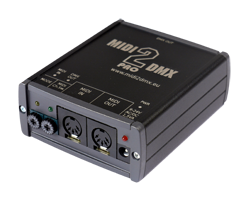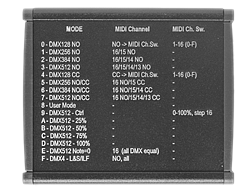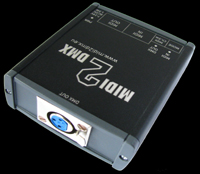
Introduction
 MIDI2DMX
(in both versions: PRO and Basic) is professional, based on the 16 MIPS
microcotroller converter , which translates MIDI messages to DMX control
signals in the real time. You may use it whereever , where you need control
DMX scene devices from the MIDI environment. MIDI2DMX enables access and
control of all 512 channels of the DMX protocol with the natural synchrosation
to the music.
MIDI2DMX
(in both versions: PRO and Basic) is professional, based on the 16 MIPS
microcotroller converter , which translates MIDI messages to DMX control
signals in the real time. You may use it whereever , where you need control
DMX scene devices from the MIDI environment. MIDI2DMX enables access and
control of all 512 channels of the DMX protocol with the natural synchrosation
to the music.
Additionally you may use standard MIDI sequencers and mixers to generate
all scene events with any kind of DMX controlled equipment (lasers, fog/smog
generators, heads, PAR' s etc.)
The control over DMX devices is realised by standard MIDI channels messages
Note ON and Control Change. Each NO and CC message holds the information about used MIDI channel,
note frequency (NO) or controller number (CC) and value of the control
(velocity for NO). Note number (frequency) in NO mode or controller number
in CC mode are available as the numbers in the range 0-127 and may be
used to choose DMX channel in the range 1-128. Beacuse of 512 DMX channels,
we need additional information to have access to channels above 128. This
is realised as classic data banking techniques. To choose needed bank
of the 128 DMX channels, this device uses MIDI channel number. Details
of the bank choosing techniques are explained in mode desriptions on the
next pages of this manual. Value of the MIDI message (i.e. Velocity for
NO) is used as a value for choosen DMX channel.
Each NO and CC message holds the information about used MIDI channel,
note frequency (NO) or controller number (CC) and value of the control
(velocity for NO). Note number (frequency) in NO mode or controller number
in CC mode are available as the numbers in the range 0-127 and may be
used to choose DMX channel in the range 1-128. Beacuse of 512 DMX channels,
we need additional information to have access to channels above 128. This
is realised as classic data banking techniques. To choose needed bank
of the 128 DMX channels, this device uses MIDI channel number. Details
of the bank choosing techniques are explained in mode desriptions on the
next pages of this manual. Value of the MIDI message (i.e. Velocity for
NO) is used as a value for choosen DMX channel.
DMX control standard uses 256 values for each channel, the range is 0-255.
MIDI message format accepts 128 values only, in the range 0-127. Because
of this diferrence, value from the MIDI message is multiplied by 2, and
therefore final range available for DMX channel is 0-254 (255 levels).

Due to consistency of the control while using Note On and Control Change
messages and due to control rules of the DMX equipment, this device uses
Note On (or Control Change) with velocity equal to 0 (zero) to "switch
of" light in the corresponding channel. Each value (Velocity) in
the DMX channel (0 or higher) will stay continuosly stable until next
message for this DMX channel will be received.
MIDI Note Off message is utilsed only in [DMX4 - L&S/ILF] mode. The
abbreviation L&S is from Light and Sound, ILF is polish abbreviation
for this mode. Details are explained below.
MIDI2DMX converter has special User Mode as well [Mode
9]. Using this mode user can prepare various variants of the DMX control
signals - fixed, dynamic, active on notes range etc. Using special software,
called DMXUser, preparing of the controls is easy. Details are described
below.
Technical data:
Power: 9-24 AC/DC, 2.1/5.5 mm plug, polarity not important
Power consumption: ca. 1,5W
Dimensions: 100x85x30 mm
Weight: ca. 250 g
Enclosure: alluminium casing with plastic caps
MIDI Input: DIN-5 socket, optical isolated
MIDI Output: DIN-5 socket, optical isolated, signal electrically
regenerated
DMX Output: XLR 3 (F) socket
MIDI IN LED:
yellow, blink - MIDI message has been received, any
channel
DMX OUT LED:
green, blink - DMX target channel was set
green, constant - DMX manual control mode #8
PWR LED:
red, 1 sec. blink - power good, microcontoler in normal
condition
red, constant, low intensity - probably to small power
voltage, check power source
red, constant, high intensity or off after blinking
- software problem, microcontroler hangs up, repluging power
(reset) required.
Please note that we supply the devices without the power
adaptor. Only a plug.
Why? We save your money this way.
1. Recycling is good - reusing is even better. Why spend
money on a (another) new adaptor since you probably have an old one laying
around? Our device is so cleverly designed that it accepts any voltage
between 9 and 24 Volts, AC or DC! You can use practically any source of
current.
We supply the plug - just cut the old plug and splice
the wires (and insulate!). You do not even have to worry about the polarity.
Any which way is fine.
And then less garbage is dumped - good for the world.
2. Power adaptors are inexpensive but heavy. You can get one locally for less than additional shipping charges due to the extra weight.
3. Non-standardized power plugs. Even in some European countries. A socket
adaptor would be hard to get and much more expensive than locally bought
power adaptor itself. On top of the shipping charges!
4. If it fails, you just use any power adaptor you can get (old or new
one). You do not have to wait till we ship you another. You have practically
no downtime. Even a trip to nearest shop takes less than waiting several
days for parcel to arrive. Not to mention paying exorbitant courries fees
(warranties do expire eventually).
